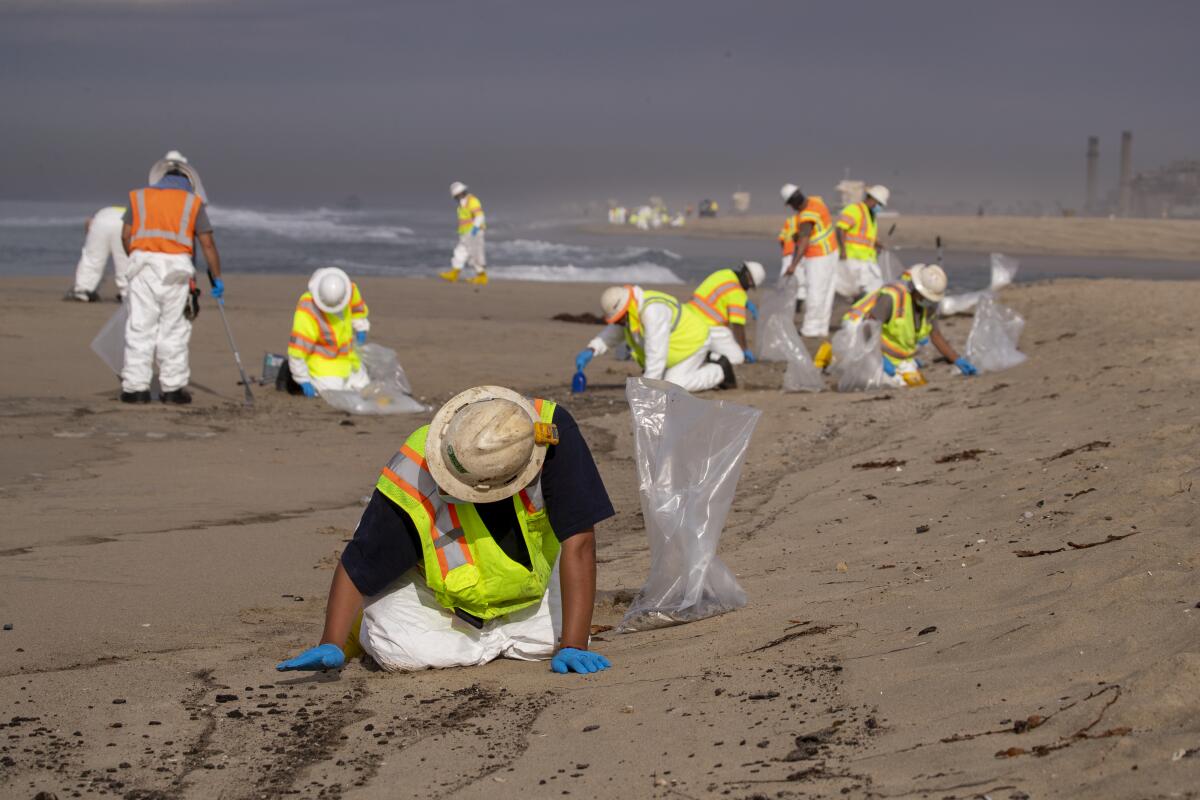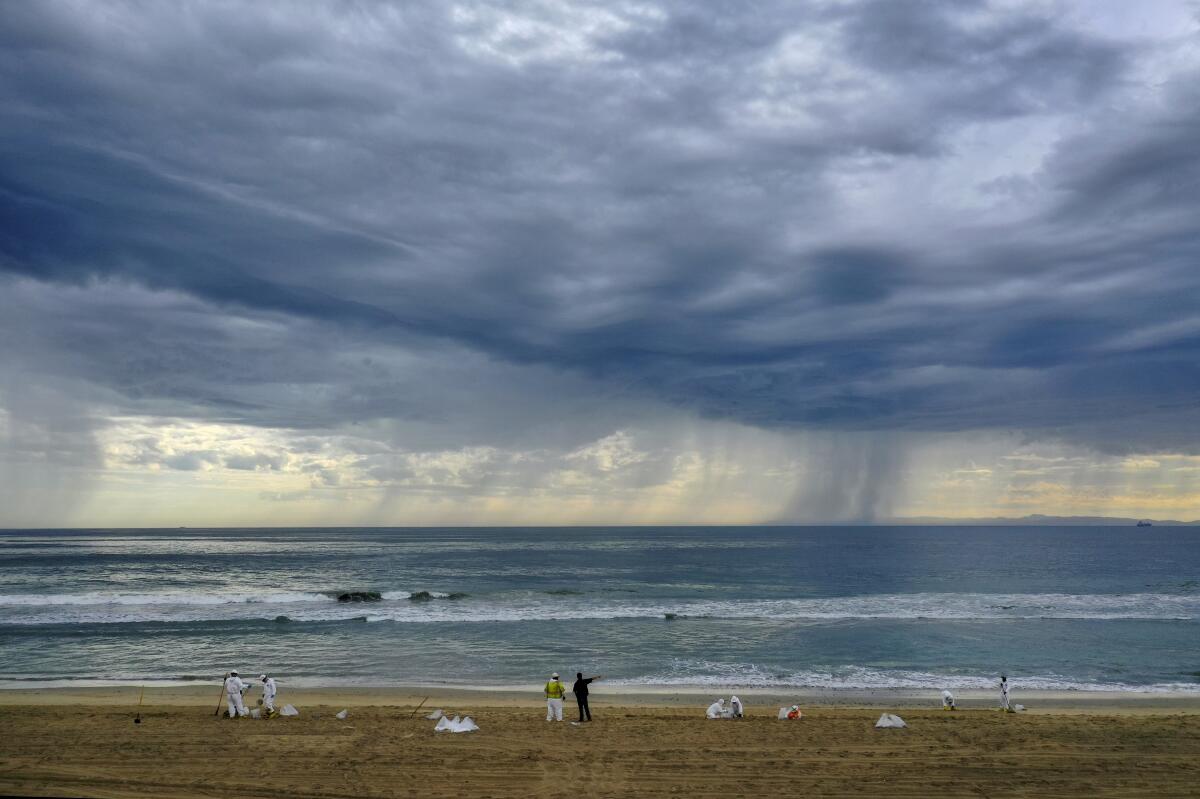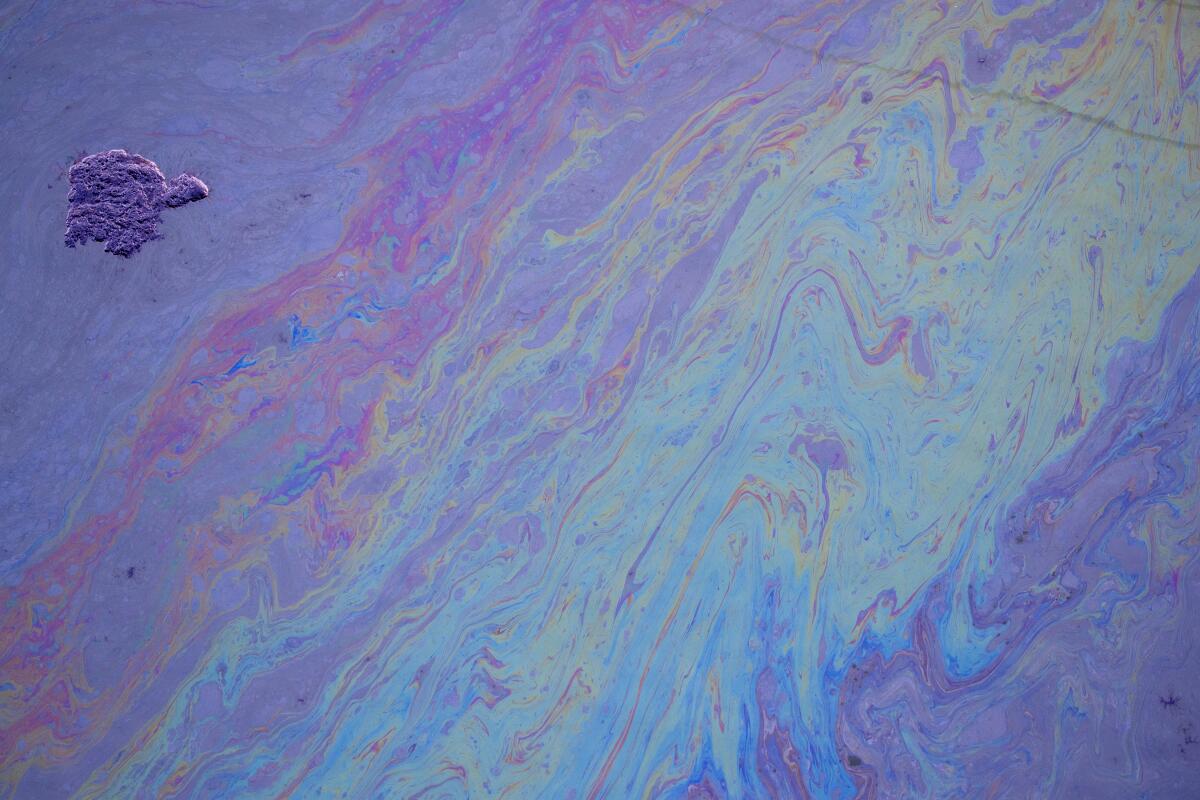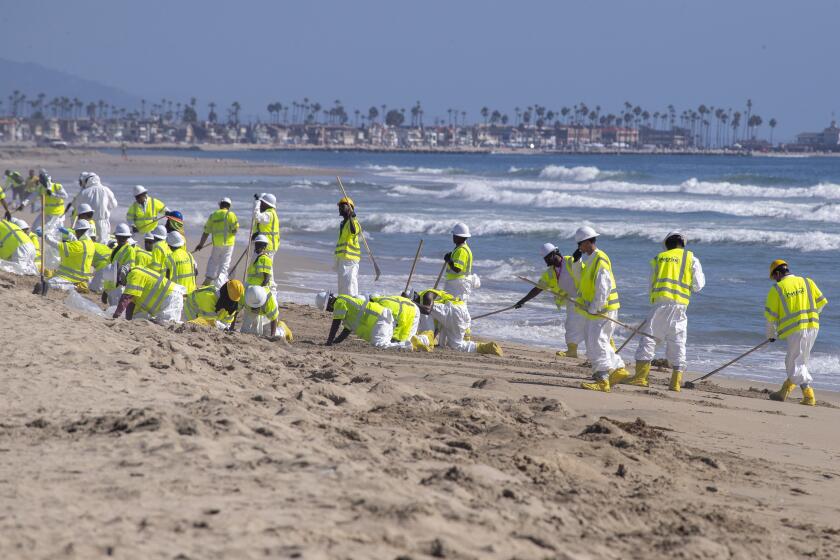Orange County oil spill sparks race to save wildlife

- Share via
The first victims are seabirds, graceful creatures that alight upon the ocean’s surface. They’ve been landing on the oil slick that seeped up from a ruptured pipeline, diving through its toxic sheen.
Larger mammals such as dolphins and whales can swim away in the short term, search for new habitat, but smaller sea creatures including shovelnose guitar fish, bat rays and horn sharks live in Southern California’s estuaries and lagoons, swim just off its coastal beaches and feed along the now-tainted shoreline off of Orange County.
Next in line are those tiny sand crabs that tickle your toes in the swash zone, where waves push up onto the sloping beachfront leaving lines of foam and clumps of oil. They’re the base of the so-called sandy beach food chain, and they don’t stand a chance if an oil spill reaches them — like the one first reported Saturday, nearly 130,000 gallons that gushed into the Catalina Channel.
A massive oil spill off the Orange County coast has fouled beaches and killed birds and marine life
The potential for damage doesn’t end there, and major questions loom: What can be cleaned? How can we clean it? How long will the spill’s effects last?
“There’s a real urgency in rescuing the wildlife affected right now, and experts have great strategies for cleaning wildlife,” said Christine Whitcraft, professor of biological sciences at Cal State Long Beach. “But I do worry about the long-term impact on oiled soil and oiled plants if it makes it to the marsh plain.”
Places such as the Talbert Marsh in Huntington Beach, a 25-acre restored wetlands where it’s possible to see up to 80 different species of bird, including great blue herons, brown pelicans, double-crested cormorants and western gulls. On Sunday, the oil had already arrived.
The state Department of Fish and Wildlife has predetermined strategies for protecting sensitives sites during disasters such as the weekend’s spill. Agency spokesman Eric Laughlin estimated Monday that there are about 600 of them statewide; the ones at risk here include Bolsa Chica Lagoon and the Talbert Marsh.

“One of the first things we did with this response is we had our scientists oversee the deployment of booms to this area to protect them,” he said. “That was our main priority. Unfortunately we have seen a light sheen in the Talbert Marsh, but we’re doing everything we can to protect those sites.”
Wildlife officials do not yet have an estimate of how many birds, fish, marine mammals and other creatures have died in the spill. But as of Monday at noon, only four birds had been collected by fish and wildlife; that number was expected to grow some by the end of the day.
The agency placed a temporary ban on commercial and recreational fishing in the region’s fisheries, an area that stretches about 20 miles from Sunset Beach south to Dana Point and extends from the shoreline out six miles into the ocean. The fear is that contaminated fish could be a health risk to anyone who eats it.

“We have a high number of fishermen and women who are mostly recent immigrants, fishing for subsistence,” said Sean Anderson, chair of the Environmental Science and Resource Management Program at Cal State Channel Islands. Fish such as white croaker “are in areas where they’re exposed to these substances, hang out onshore and are easily targeted by fishermen. They sequester the toxins in their tissues. It’s safer for the fish, but if we eat the fish, it’s a problem.”
Anderson has researched oil spills in California, Louisiana and the Middle East. After the 2015 oil spill that fouled the region near Refugio State Beach in Santa Barbara County, Anderson documented the death of the thumbnail-sized sand crabs, also known as mole crabs, “which are the base of our sandy beach ecosystem. Everything eats them,” he said. “They’re right where the waves are breaking, perfectly aligned to get dumped on by this incoming oil.”
By the time the oil hits them, it’s usually so-called weathered oil, which has been exposed to air, sunlight and wave action. It’s often in gooey balls mixed with sand called “cookies.” Untouched, Anderson said, it’s not as toxic as “the raw stuff coming out of the pipeline. ... Once a critter steps on it, breaks open the crust, the more toxic crap is inside.”
Anderson and his colleagues collected weathered oil, brought it into their labs and exposed clean, healthy sand crabs to it. The result was a lot of dead sand crabs, even at low concentrations of the toxic chemicals in the oil.

“If it doesn’t kill them,” he said, “it’ll kill and poison their eggs, their babies. This isn’t permanent, but there absolutely is a strong impact on the sandy beach. ... Nobody saves or cleans sand crabs.”
They do try to save and clean birds that end up coated in oil.
Oil affects seabirds in two particularly harmful ways. Feathers create pockets of air that insulate birds from dangerously low temperatures and keep them warm, Anderson said. When they’re covered in sludge, those pockets disappear and birds can suffer from hypothermia.
Birds keep their feathers fluffed — and therefore protective — by preening. But each time they plunge their beaks into oil-drenched feathers, they ingest some of the toxic substances while trying to clean themselves. They can throw up or get dizzy in the short term, Anderson said. Over the course of hours or days, if they live that long, their organs may shut down.
But cleaning an oiled bird is more of an art than a science, said Michael Ziccardi, director of the Oiled Wildlife Care Network.
First, birds are placed in a tub filled with a solution of warm water and liquid dishwashing detergent. Agitating the solution allows it to penetrate the space beneath and through the bird’s feathers. Next, a Water Pik device is used to clean the bird’s sensitive areas — near the eyes, nose and mouth.
“As the tubs of water get oiled, we’ll move to the next tub,” Ziccardi said. “Heavily, heavily oiled birds can take 15 to 20 tubs of this soapy water.”
After that, the soapy bird has to be thoroughly rinsed with specialized nozzles using water pressure anywhere from 20 to 50 pounds per square inch. That’s because “the microstructure of feathers is almost like Velcro,” Ziccardi said, and the soap used to clean the bird also prevents its feathers from properly realigning.
“The pieces of Velcro have to fit back together for the feathers to be waterproof,” he said in an interview. “You’re actually rinsing it dry. The longer you rinse the soap off, the feathers will start regaining that structure, and you’ll actually have water starting to bead up on the outside of the bird.”
According to Ziccardi, the Oiled Wildlife Care Network has a 50%-75% success rate in returning oiled animals back into a clean environment.
The three oiled birds found Sunday include a brown pelican, an American coot and a duck. The pelican had extensive injuries and had to be euthanized, Ziccardi said. A fourth bird, a sanderling, came in Monday.
Ziccardi called the number of rescued birds so far “surprisingly low.” It’s possible migratory patterns aligned with the spill and the region’s wildlife caught a lucky break. Undoubtedly, more animals have been affected, he said, adding that “there are going to be more animals out there that are affected by this incident than the number of animals we can actually collect.”
He also warned that the public “should not try to catch oiled animals — it’s not safe.” Rescuers aren’t accepting volunteers from the public, he said, because “we have people trained upwards a week or more” and they are “ready” to execute.
It’s a warning that well-meaning animal lovers need to heed.
As city cars and workers patrolled quiet stretches of beach now closed to the public, tourists and residents strolled along Huntington Pier, chatting about the weekend’s startling disaster and what restaurant to explore for dinner. Their talk turned to the “emptiness on the sand,” with hardly the sound of dog barks on the boardwalk or of billowing birds.
Drake Bates, a grocery store stocker feeding his dachshund a coffee cup filled with whipped cream, said that, as an animal lover, he worries about creatures facing harm as a result of spilling oil.
“If I see someone or something hurt, of course I would try to help,” said the Huntington Beach local who walks near the water almost daily. “I would clean it, take it home to recover, then bring it back.”
His mother told him about a “cleansing event” for pets and other critters held around the area, he said, intending to research it.
“If I don’t help right away, who will? I would wear gloves. I wouldn’t wait for the last minute,” Bates said, “since it might be too late.”
Maurice Lawson, who studied kinesiology at the University of La Verne, said he, too, would feel compelled to assist. But he would do so by tapping the experts.
“There are resources and people who know the right stuff who we call,” the Brea resident said. “Mishaps happen and it affects everyone, not just human beings. We need to protect ecosystems and protect marine life.
“Like calling 911 for emergencies, you need to reach out to the ones with training.”
Times staff writer Brittny Mejia contributed to this report.
More to Read
Sign up for Essential California
The most important California stories and recommendations in your inbox every morning.
You may occasionally receive promotional content from the Los Angeles Times.

















